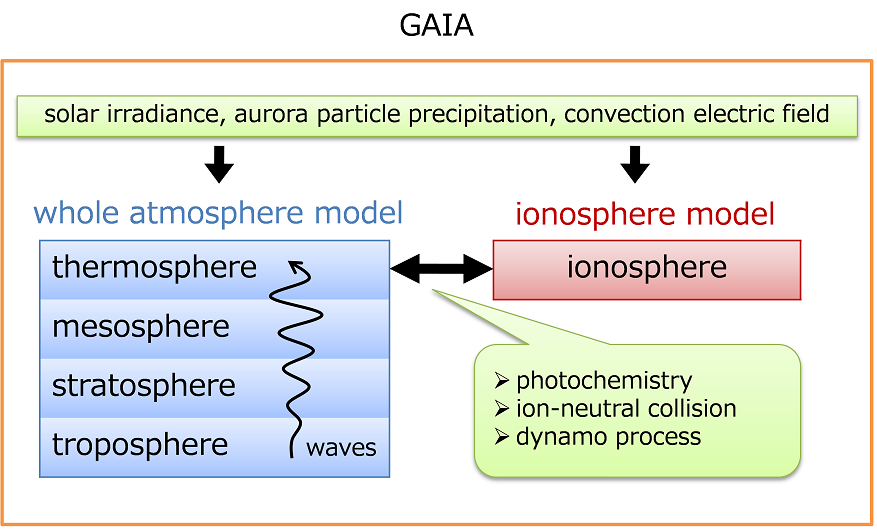Welcome to GAIA project site
Latest News
- 2024/07
- Presentations will be held at COSPAR meeting.
- 2024/05
- Presentations were held at JpGU meeting.
About GAIA project
The GAIA project combines atmospheric and ionospheric models (developed separately thus far), and targets the development of a simulation model for the whole global atmosphere. Upon being realized, this model will provide a powerful means of studying and solving such upper atmosphere issues as the vertical coupling in the Earth’s atmosphere. This project is also aimed at reproducing actual upper atmospheric variations by assimilating observation data into the GAIA model.

Purpose of GAIA project
The demand for quantitative predictions of the situation in the upper atmospheric region has increased, along with brisker human activities in space in recent years. And in conjunction with the effects stemming from human activities, it has become more important to understand the long-term process of atmospheric variations. Thus, the development of a global atmospheric model is considered beneficial for such demand in the future.
In the field of academic research on the upper atmosphere, however, the coupling to the lower atmosphere has been an essential issue. Evidence regarding the interrelationship between ionospheric and tropospheric variations has been consistently reported based on recent observations using satellites and ground-based radars. A model applicable to the entire atmospheric region is thus needed to understand such vertical coupling from the troposphere through the ionosphere, as variations propagating across regions with different characteristics and complex dynamics must be handled.
Against such a background, efforts to develop models describing the vertical coupling in the Earth's atmosphere have intensified worldwide. This project aims to build the world's first global atmospheric model by mobilizing domestic resources. For this purpose, research using the GAIA model will address the following issues:
- Understanding the process of vertical coupling in the Earth’s atmosphere
- Relation between lower atmospheric weather and space weather (daily variations in the ionosphere and thermosphere)
- Relation between climatic changes in the lower atmosphere and long-term changes in the upper atmosphere
- Understanding the interacting processes between the neutral atmosphere and ionospheric plasma in the upper atmosphere
- Understanding the process of how disturbances occur in the ionosphere and thermosphere due to solar flares or magnetic storms
- Building a base model for numerically predicting space weather
Members
Atmospheric model
- Yasunobu Miyoshi
- Kyushu University (miyoshi_AT_geo.kyushu-u.ac.jp)
- Hitoshi Fujiwara
- Seikei University (h_fujiwara_AT_st.seikei.ac.jp)
Ionospheric model
- Hiroyuki Shinagawa
- NICT (sinagawa_AT_nict.go.jp)
- Kaori Terada
- Tohoku University
Electrodynamics model part
- Hidekatsu Jin
- NICT (jin_AT_nict.go.jp)
Model experiments & extension
- Mitsuru Matsumura
- Ryosuke Yasui
- Meteorological Research Institute
- Satoshi Andoh
- NICT
- Chihiro Tao
- NICT (chihiro.tao_AT_nict.go.jp)
Model coupling method
- Naoki Terada
- Tohoku University
- Takashi Tanaka
- Kyushu University/NICT
- Akimasa Yoshikawa
- Kyushu University
Observations and Comparisons
- Shigeru Fujita
- Meteorological College
- Yuichi Otsuka
- Nagoya University
- Akinori Saito
- Kyoto University
- Mamoru Ishii
- NICT
- Takuya Tsugawa
- NICT
- Huixin Liu
- Kyushu University
Acknowledgement
-MEXT Grant-in-Aid for Scientific Research (B) in Japan (21H01150)
-MEXT Grant-in-Aid for Scientific Research (C) in Japan (19K03942)
-MEXT Grant-in-Aid for Scientific Research (B) in Japan (15H03733)
-MEXT Grant-in-Aid for Scientific Research (B) in Japan (23340149)
-MEXT Grant-in-Aid for Scientific Research (B) in Japan (23340144)
-MEXT Grant-in-Aid for Scientific Research on Innovative Areas (20200047)